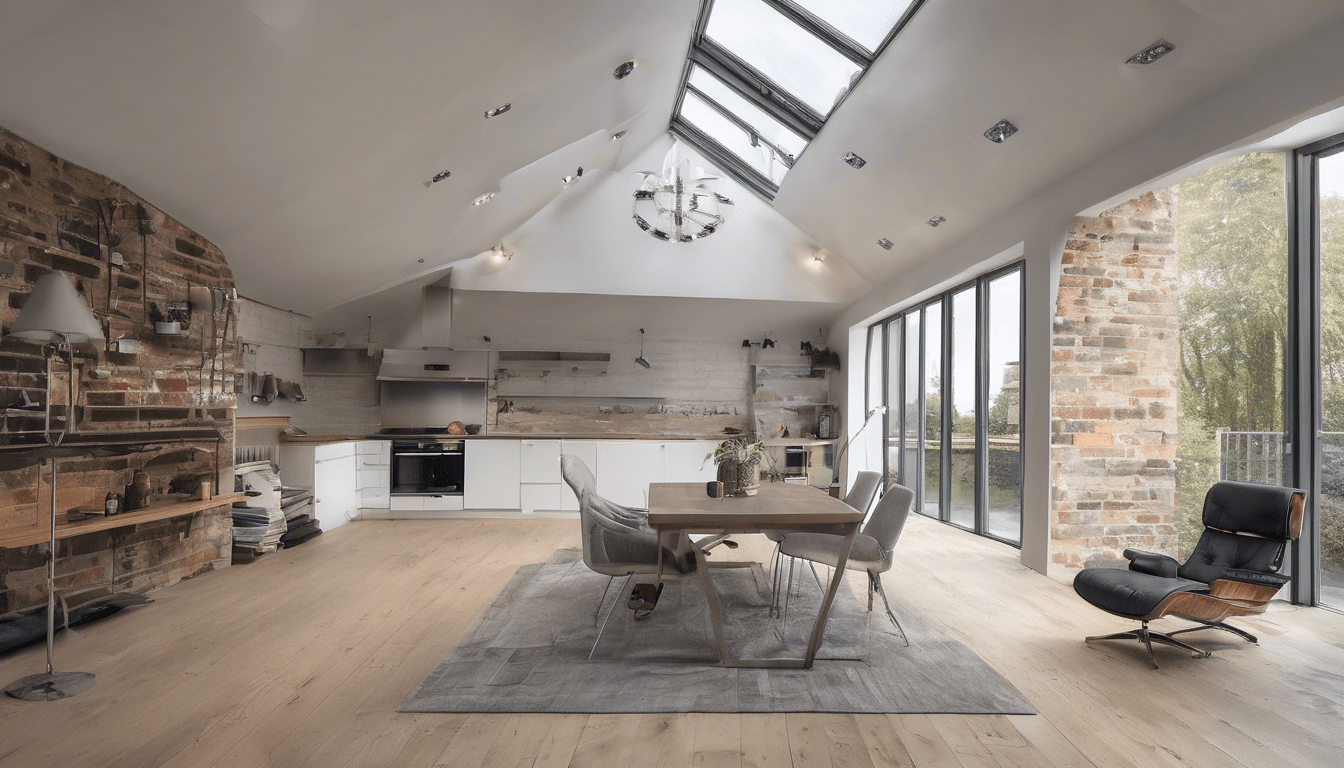Top reasons to engage an architect for loft conversions

Engaging an architect for a loft conversion elevates the project from simple remodeling to a tailored, high-quality upgrade. Their expertise ensures optimal use of space, legal compliance, and aesthetic appeal, all while managing costs and reducing risks. By collaborating with a professional, homeowners benefit from innovative design, increased property value, and long-term durability—transforming an underused area into a functional, stylish part of the home.
The Role of an Architect in Loft Conversions
Understanding the essential contributions of architects in transforming your attic space.
Also to discover : What’s the Latest on Adaptive Learning Technologies in UK’s Education System?
An architect plays a pivotal role in loft conversions by crafting tailored designs that make the most of available space while enhancing the overall aesthetic of your home. Through professional design and planning, architects maximize functionality without compromising style. Their expertise ensures every corner is efficiently utilized, creating bright, inviting rooms that respond to your specific needs.
Careful planning by an architect is crucial, particularly to guarantee the structural integrity and safety of the loft conversion. Architects assess and reinforce existing foundations and frameworks, anticipating challenges that might arise during construction. This careful foresight prevents costly mistakes and avoids potential hazards, ensuring your new space is secure and durable.
Have you seen this : What Are the Key Drivers for the Growth of UK’s Vegan Food Market?
Moreover, architects collaborate closely with you to customize the design according to your lifestyle and preferences. They listen attentively and translate your vision into practical architectural solutions that work harmoniously with your home’s structure. This client-centered approach results in loft conversions that are not only beautiful but truly functional. For those considering such a project, consulting an Architect for loft conversion can provide invaluable guidance from concept through completion.
Ensuring Regulatory Compliance and Building Codes
Understanding the legal and safety framework
When undertaking a loft conversion, navigating local planning permissions and building regulations is crucial. These regulations vary depending on your location but generally cover aspects such as structural safety, fire protection, insulation, and ventilation. An architect ensures your project aligns with these regulations, helping prevent costly delays or reworks.
How do architects ensure loft conversions meet safety standards and legal requirements? Precisely by conducting thorough assessments and preparing detailed plans that comply with all relevant building codes. They consider load-bearing capacities, emergency exits, and materials used to guarantee structural integrity and occupant safety.
The role of an architect in managing approval processes efficiently cannot be overstated. By liaising with local authorities and submitting accurate documentation, architects streamline permissions and approvals. This proactive approach reduces the risk of applications being rejected or delayed, providing peace of mind throughout your loft conversion journey.
Enhancing Project Efficiency and Cost-Effectiveness
Efficient project management is essential for a successful loft conversion. Hiring an Architect for loft conversion brings professional planning that streamlines the entire construction timeline. By coordinating schedules and anticipating challenges, this expert approach minimizes delays and helps keep the project on track.
Cost control is another critical factor. Early involvement of an architect enables identification of cost-saving opportunities without sacrificing quality. They can suggest materials and designs that balance aesthetic appeal with affordability, ensuring the budget is maximized effectively.
Moreover, expert oversight significantly reduces the risk of costly mistakes. Mistakes during construction often escalate costs and cause delays. An architect’s detailed supervision monitors progress and compliance with building regulations, detecting issues before they become expensive problems. This proactive management supports a smoother, more cost-effective loft conversion.
Design Quality and Aesthetic Value
The design quality of a loft conversion is fundamental to creating a space that is both functional and visually appealing. Integrating innovative design features goes beyond merely adding square footage; it enhances living comfort and style. For instance, clever storage solutions and multi-purpose areas can maximize usability without compromising on aesthetics.
An Architect for loft conversion plays a vital role by applying their architectural expertise to optimize natural light and ventilation. By carefully positioning windows, skylights, and vents, these professionals ensure that the converted loft remains bright and airy, contributing to a healthier living environment. This attention to natural light not only improves the room's atmosphere but also reduces energy costs.
Custom finishes and choice materials contribute significantly to a loft’s appeal. Selecting high-quality, visually striking materials can elevate the entire space, increasing property value. From elegant wood flooring to bespoke cabinetry, every detail matters when aiming for a design that stands out.
In sum, prioritizing design quality and utilising skilled architects will result in a loft conversion that blends seamlessly with your home’s character, ensuring both functionality and lasting aesthetic value.
Long-Term Value and Investment Benefits
A professional loft conversion offers more than just extra space; it can significantly increase property value. Expertly designed and constructed lofts appeal broadly to buyers, often resulting in a higher resale price. When engaging an experienced architect for a loft conversion, the focus is on creating a functional, stylish addition that complements the existing structure, which contributes to a durable and price-worthy result.
An important aspect to consider is the longevity and durability of the loft space. Quality materials and thoughtful design choices ensure the conversion withstands wear, changes in use, and evolving building standards. This means homeowners benefit from a low-maintenance area that remains attractive and functional for many years.
Architects play a vital role in future-proofing your loft. They design spaces with adaptability in mind, so the area can evolve alongside your needs or potential market demands. For instance, a loft initially used as a bedroom might later suit a home office or rental unit without costly modifications. This foresight enhances the loft’s practical value and appeal, securing your investment in the long term.
For those considering such enhancements, consulting an Architect for loft conversion can ensure the project maximizes both immediate and lasting benefits.
The Advantages of Hiring a Qualified Architect
Expertise and Reliability
Hiring a qualified architect for your loft conversion ensures your project benefits from accredited expertise and reliability. Accredited architects bring years of experience and specialized knowledge, crucial for navigating building regulations and structural challenges unique to loft conversions. Their professional insight helps prevent costly mistakes, ensuring your loft is both safe and functional.
Selecting reputable architecture professionals means prioritizing credentials, portfolios, and client feedback these elements reveal commitment to quality and innovation. An architect’s involvement can increase overall satisfaction by delivering designs that maximize space, light, and usability according to your specific needs.
The impact of professional guidance extends beyond design. Architects coordinate with contractors and regulatory bodies, smoothing the planning process and avoiding delays. Their expert advice can also enhance the aesthetic value and resale potential of your property. Engaging an experienced architect is an investment that safeguards the success and longevity of your loft conversion.
The Process of Engaging an Architect for a Loft Conversion
When considering a loft conversion, engaging an architect is a crucial step to ensure your project runs smoothly from start to finish. The process begins with an initial assessment and feasibility study. During this phase, the architect will evaluate the existing structure, measure dimensions, and identify potential challenges such as building regulations or structural limitations. This step provides clarity on what is possible within your space and budget.
Once feasibility is confirmed, the architect moves to concept development. This involves creating detailed drawings that translate your vision into practical designs. They will consider light, space, and usability, making sure the layout maximizes the loft's potential. These drawings are essential for securing planning approval from local authorities, which is often necessary before construction can commence. Clear and accurate plans help avoid delays and additional costs.
Throughout construction, the architect's role shifts to overseeing the project to ensure builders adhere to the agreed design specifications. This supervision helps maintain the quality and integrity of the loft conversion, addressing any issues promptly. For anyone navigating a loft conversion, understanding these stages clarifies the importance of an architect who coordinates from concept through completion. Finding the right Architect for loft conversion can make all the difference in delivering a tailored, functional, and beautiful space.
